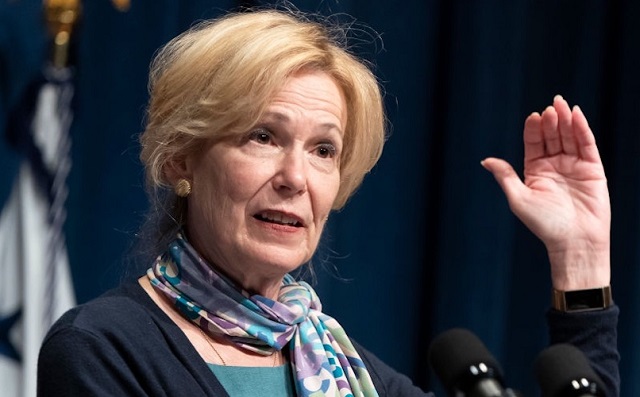Brownstone Institute
Ketanji Brown Jackson Defenestrates the First Amendment

From the Brownstone Institute
At her confirmation hearings, Justice Ketanji Brown Jackson claimed she lacked the expertise to define “woman.” Just two years later, she did not hesitate to redefine the First Amendment and free speech as she advocated for the regime to bulldoze our Constitutional liberties provided they offer sufficiently sanctimonious justifications.
At Monday’s oral arguments in Murthy v. Missouri, Jackson said her “biggest concern” was that the injunction, which prohibits the Biden Administration from colluding with Big Tech to censor Americans, may result in “the First Amendment hamstringing the Government.”
This, apparently, was of greater concern to Jackson than the revelations that the Intelligence Community held ongoing meetings with social media companies to coordinate censorship demands, that the White House explicitly demanded the censorship of journalists, and that the Department of Homeland Security was instrumental in manipulating citizens ahead of the 2020 presidential election.
But according to Jackson’s outlook, those facts may have actually been encouraging. She scolded counsel, “Some might say the Government actually has a duty to take steps to protect the citizens of this country.”
Jackson’s formulation inverts the structure of constitutional liberties. The Constitution does not limit the powers of citizens; it restrains our elected officials from tyrannical overreach. It is the law that “governs those who govern us,” as law professor Randy Barnett explains.
Impediments to state powers are not flaws in the system; they are the essence of the design. But Jackson offers no deference to these constitutional restraints. Instead, she explained, “I am really worried about…the First Amendment operating in an environment of threatening circumstances.”
Of course, the First Amendment was designed for environments of threatening circumstances. American history offers no shortage of threats that could be justified to abridge our liberties – from Cholera and Yellow Fever to polio and Spanish flu; from the Red Coats and the XYZ Affair to the Red Army and the War on Terror; from conquering the west to defeating the Nazis.
The Framers understood the ineradicable threat that power poses to liberty, which is why they were unequivocal that the Government cannot “abridge” constitutionally protected speech, no matter the moral surety of the censors.
At times, the country has failed to live up to this promise, but those instances are rarely heralded. Jackson’s deference to emergencies or “threatening circumstances” is precisely the logic that the Court used to intern the Japanese and jail Eugene Debs. More recently, censors invoked that familiar paternalism to justify censorship of the origin of Covid and the veracity of Hunter Biden’s laptop.
But the Constitution demands a different path, as explained by Louisiana Solicitor General Benjamin Aguinaga in response to Jackson. The choice between liberty and safety is a false binary. “The Government can’t just run rampant pressuring the platforms to censor private speech,” Aguinaga explained.
The Biden Administration can promote its interests, deliver its own speeches, and purchase its preferred PSAs. It cannot, however, use vapid slogans of paternalism to usurp the First Amendment.
Justice Alito appeared to see through the justifications for censorship in his questioning of Brian Fletcher, Biden’s Deputy Solicitor General. He asked:
“When I see that the White House and federal officials repeatedly say that Facebook and the federal government should be ‘partners,’ [or] ‘we are on the same team.’ [GOVERNMENT] Officials are demanding answers, ‘I want an answer. I want it right away.’ When they’re unhappy, they curse them out…The only reason why this is taking place is that the federal government has got Section 230 and antitrust in its pocket…And so it’s treating Facebook and these other platforms like their subordinate.Would you do that to the New York Times, The Wall Street Journal, the Associated Press, or any other big newspaper or wire service?”
Meanwhile, Jackson could not grasp the most basic tenets of the First Amendment or free speech. Instead, she fear-mongered with absurd questions of whether the State has a compelling interest in stopping teens from “jumping out of windows.”
In the process, Jackson revealed her intent to defenestrate the First Amendment alongside her fictitious adolescent victims. Her “biggest concern” is that the First Amendment may hinder the regime’s pursuit of power, just as it was designed to do.
Tyranny has long draped itself in cloaks of benevolent phrasing. The judiciary is meant to safeguard our liberties from aspiring tyrants, even if they espouse the socially fashionable shibboleths of the day. Jackson does not just abdicate that responsibility; she appears to abhor it. We must hope her peers on the Court retain their oath to the Constitution.
It was especially striking for many people listening to these arguments to become aware of the astonishing lack of sophistication on the part of some of these Justices, Jackson in particular, and others had their moments.
The sidewalks outside the court were filled with actual experts, people who have followed this case closely since its inception, victims of the censorship industrial complex, and people who have read every brief and scoured through the evidence.
These actual experts and dedicated citizens who know the facts inside and out stood on the sidewalks outside the case while the plaintiffs’ attorney scrambled within the time limits to introduce the topic, possibly for the first time, to these men and women who hold the future of freedom in their hands.
Unbeknownst to themselves, the Justices themselves are victims of the censorship industrial complex. They could themselves have been plaintiffs in this very case, since they too are consumers of information using technology. And yet, given their status and position, they had to pretend to be above it all, knowing what others do not know, though clearly they did not.
It was frustrating scene, to say the least.
Sadly, the oral arguments became bogged down in minutiae over plaintiff standing, the particular wording of this or that email, various farflung hypotheticals, and hand wringing over what will become of the influence of our overlords should the injunction take place. Lost in this thicket of confusion was the bigger trajectory: the clear ambition on the part of the administrative state to become the master curator of the Internet in order to disable the whole promise of a democratized communication technology and introduce full control of the public mind.
A clear-headed court would strike down the entire ambition. That will not happen, apparently. That said, perhaps it is a very good sign that at least, and after so many years of this deep-state meddling in information flows, the issue has finally gotten the attention of the highest court.
May this day become a catalyst for what is needed most of all: the formation of a hard-core of informed citizens who absolutely refuse to go along with the censorship no matter what.
Brownstone Institute
The WHO’s Proposed Pandemic Agreements Worsen Public Health

From the Brownstone Institute
BY
The WHO decided that the response for a Toronto aged care resident and a young mother in a Malawian village should be essentially the same – stop them from meeting family and working, then inject them with the same patented chemicals.
Much has been written on the current proposals putting the World Health Organization (WHO) front and center of future pandemic responses. With billions of dollars in careers, salaries, and research funding on the table, it is difficult for many to be objective. However, there are fundamentals here that everyone with public health training should agree upon. Most others, if they take time to consider, would also agree. Including, when divorced from party politicking and soundbites, most politicians.
So here, from an orthodox public health standpoint, are some problems with the proposals on pandemics to be voted on at the World Health Assembly at the end of this month.
Unfounded Messaging on Urgency
The Pandemic Agreement (treaty) and IHR amendments have been promoted based on claims of a rapidly increasing risk of pandemics. In fact, they pose an ‘existential threat’ (i.e. one that may end our existence) according to the G20’s High Level Independent Panel in 2022. However, the increase in reported natural outbreaks on which the WHO, the World Bank, G20, and others based these claims is shown to be unfounded in a recent analysis from the UK’s University of Leeds. The main database on which most outbreak analyses rely, the GIDEON database, shows a reduction in natural outbreaks and resultant mortality over the past 10 to 15 years, with the prior increase between 1960 and 2000 fully consistent with the development of the technologies necessary to detect and record such outbreaks; PCR, antigen and serology tests, and genetic sequencing.
The WHO does not refute this but simply ignores it. Nipah viruses, for example, only ‘emerged’ in the late 1990s when we found ways to actually detect them. Now we can readily distinguish new variants of coronavirus to promote uptake of pharmaceuticals. The risk does not change by detecting them; we just change the ability to notice them. We also have the ability to modify viruses to make them worse – this is a relatively new problem. But do we really want an organization influenced by China, with North Korea on its executive board (insert your favorite geopolitical rivals), to manage a future bioweapons emergency?
Irrespective of growing evidence that Covid-19 was not a natural phenomenon, modelling that the World Bank quotes as suggesting a 3x increase in outbreaks over the next decade actually predicts that a Covid-like event will recur less than once per century. Diseases that the WHO uses to suggest an increase in outbreaks over the past 20 years, including cholera, plague, yellow fever, and influenza variants were orders of magnitude worse in past centuries.
This all makes it doubly confusing that the WHO is breaking its own legal requirements in order to push through a vote without Member States having time to properly review implications of the proposals. The urgency must be for reasons other than public health need. Others can speculate why, but we are all human and all have egos to protect, even when preparing legally binding international agreements.
Low Relative Burden
The burden (e.g. death rate or life years lost) of acute outbreaks is a fraction of the overall disease burden, far lower than many endemic infectious diseases such as malaria, HIV, and tuberculosis, and a rising burden of non-communicable disease. Few natural outbreaks over the past 20 years have resulted in more than 1,000 deaths – or 8 hours of tuberculosis mortality. Higher-burden diseases should dominate public health priorities, however dull or unprofitable they may seem.
With the development of modern antibiotics, major outbreaks from the big scourges of the past like Plague and typhus ceased to occur. Though influenza is caused by a virus, most deaths are also due to secondary bacterial infections. Hence, we have not seen a repeat of the Spanish flu in over a century. We are better at healthcare than we used to be and have improved nutrition (generally) and sanitation. Widespread travel has eliminated the risks of large immunologically naive populations, making our species more immunologically resilient. Cancer and heart disease may be increasing, but infectious diseases overall are declining. So where should we focus?
Lack of Evidence Base
Investment in public health requires both evidence (or high likelihood) that the investment will improve outcomes and an absence of significant harm. The WHO has demonstrated neither with their proposed interventions. Neither has anyone else. The lockdown and mass vaccination strategy promoted for Covid-19 resulted in a disease that predominantly affects elderly sick people leading to 15 million excess deaths, even increasing mortality in young adults. In past acute respiratory outbreaks, things got better after one or perhaps two seasons, but with Covid-19 excess mortality persisted.
Within public health, this would normally mean we check whether the response caused the problem. Especially if it’s a new type of response, and if past understanding of disease management predicted that it would. This is more reliable than pretending that past knowledge did not exist. So again, the WHO (and other public-private partnerships) are not following orthodox public health, but something quite different.
Centralization for a Highly Heterogeneous Problem
Twenty-five years ago, before private investors became so interested in public health, it was accepted that decentralization was sensible. Providing local control to communities that could then prioritize and tailor health interventions themselves can provide better outcomes. Covid-19 underlined the importance of this, showing how uneven the impact of an outbreak is, determined by population age, density, health status, and many other factors. To paraphrase the WHO, ‘Most people are safe, even when some are not.’
However, for reasons that remain unclear to many, the WHO decided that the response for a Toronto aged care resident and a young mother in a Malawian village should be essentially the same – stop them from meeting family and working, then inject them with the same patented chemicals. The WHO’s private sponsors, and even the two largest donor countries with their strong pharmaceutical sectors, agreed with this approach. So too did the people paid to implement it. It was really only history, common sense, and public health ethics that stood in the way, and they proved much more malleable.
Absence of Prevention Strategies Through Host Resilience
The WHO IHR amendments and Pandemic Agreement are all about detection, lockdowns, and mass vaccination. This would be good if we had nothing else. Fortunately, we do. Sanitation, better nutrition, antibiotics, and better housing halted the great scourges of the past. An article in the journal Nature in 2023 suggested that just getting vitamin D at the right level may have cut Covid-19 mortality by a third. We already knew this and can speculate on why it became controversial. It’s really basic immunology.
Nonetheless, nowhere within the proposed US$30+ billion annual budget is any genuine community and individual resilience supported. Imagine putting a few billion more into nutrition and sanitation. Not only would you dramatically reduce mortality from occasional outbreaks, but more common infectious diseases, and metabolic diseases such as diabetes and obesity, would also go down. This would actually reduce the need for pharmaceuticals. Imagine a pharmaceutical company, or investor, promoting that. It would be great for public health, but a suicidal business approach.
Conflicts of Interest
All of which brings us, obviously, to conflicts of interest. The WHO, when formed, was essentially funded by countries through a core budget, to address high-burden diseases on country request. Now, with 80% of its use of funds specified directly by the funder, its approach is different. If that Malawian village could stump up tens of millions for a program, they would get what they ask for. But they don’t have that money; Western countries, Pharma, and software moguls do.
Most people on earth would grasp that concept far better than a public health workforce heavily incentivized to think otherwise. This is why the World Health Assembly exists and has the ability to steer the WHO in directions that don’t harm their populations. In its former incarnation, the WHO considered conflict of interest to be a bad thing. Now, it works with its private and corporate sponsors, within the limits set by its Member States, to mold the world to their liking.
The Question Before Member States
To summarize, while it’s sensible to prepare for outbreaks and pandemics, it’s even more sensible to improve health. This involves directing resources to where the problems are and using them in a way that does more good than harm. When people’s salaries and careers become dependent on changing reality, reality gets warped. The new pandemic proposals are very warped. They are a business strategy, not a public health strategy. It is the business of wealth concentration and colonialism – as old as humanity itself.
The only real question is whether the majority of the Member States of the World Health Assembly, in their voting later this month, wish to promote a lucrative but rather amoral business strategy, or the interests of their people.
Brownstone Institute
Medical Elites’ Disgrace Over Ivermectin

From the Brownstone Institute
BY
In the wake of the FDA settling a lawsuit brought against it for wantonly and aggressively smearing ivermectin, the agency has deleted its postings. That’s good, but we shouldn’t forget how egregiously it mischaracterized the drug, ignored copious evidence in its favor, and portrayed its proponents as dangerous crackpots.
About 30 months ago, America’s FDA was publishing articles with headlines like this: “Should I take ivermectin to treat COVID?” Answer: No. The agency also told Americans not to use ivermectin to prevent Covid. Then, in what became known as its infamous “horse tweet,” the FDA even patronizingly told Americans: “Seriously, y’all. stop it.”
Prescribers who advocated for alternate treatments like ivermectin or hydroxychloroquine were mocked online by America’s “trusted journalists” as being part of a “right-wing conspiracy” and labeled “hucksters.” Those who didn’t demure to the Covid mRNA or other Big Pharma treatment narratives were banned, fired, and spoken harshly about around the world and into the reaches of the stratosphere in what seemed like coordinated messaging.
Many clinicians lost their jobs – at best. At worst, their reputations, practices, finances, and careers were shattered. If that was not bad enough, after losing their jobs, state medical and pharmacy boards initiated legal proceedings against their licensure, singling out their “off-label” Covid treatments, despite other off-label treatments being a near-ubiquitous component of pharmacy and medical practice.


Within days of FDA’s initial postings above, the American Pharmacist’s Association (APhA) the American Society of Health System Pharmacists (ASHP), and the American Medical Association (AMA) all collaborated to release a joint press release condemning doctors who prescribed ivermectin to treat Covid, but it appears that these organizations, instead of actually performing independent analysis of primary literature data, blindly regurgitated FDA, CDC, and NIH plus other government and Big Pharma talking points “strongly opposing” ivermectin use.
For generations and especially during the Covid pandemic, professionals depended on these “elite” medical groups. Some of them have existed for around 170 years and have around $150 million to $1.2 billion in assets, so they clearly had the history, personnel, and wherewithal to objectively examine published data. Even beyond that, the AMA has several floors in a skyscraper in Chicago and the APhA’s Constitution Avenue’s “landmark headquarters” is so luxuriant that it is advertised and utilized as a wedding venue.
Of course, that extravagance was paid for by millions of pharmacists, physicians, and benefactors who expected these organizations to act as a checksum and ensure excellent clinical practice standards. These medical organizations have a duty to honor their histories, responsibilities, and ethical duties to better the human condition through verified scientific evidence. Instead, they appeared to outrageously abandon their obligations from their lofty positions of respect, comfort, money, and power.
APhA, ASHP, and AMA Clinical Declarations Now Indefensible:
On March 22, the FDA rightly acquiesced and agreed to remove their anti-ivermectin postings due to 1) a lawsuit filed against them and 2) the impossible task of having to defend themselves with an overwhelming amount of data disagreeing with not only dispensing medical recommendations, but the published data backing their Covid-19 use (e.g., see below).
With that gone, the APhA, ASHP, and AMA assertions suddenly have no leg upon which to stand.
Several non-FDA links within their press releases have (unsurprisingly) also quietly vanished with no explanation. NIH references are slated to be shut down, on top of multiple FDA and CDC links already no longer working.
Ivermectin Mechanism of Action, History and Evidence:
The broad antiviral mechanism of action of ivermectin is complicated and may partially involve blocking the uptake of viral proteins, but the bottom line is that it has been shown to yield positive results in a variety of published results for Covid-19. Had APhA, ASHP, and AMA pharmacists and physicians independently examined the data, (as I, just one drug-safety analyst without fancy headquarters, have done) rather than simply parroting now-deleted narratives of others, they would have learned that ivermectin works as an antiviral.
It has an extensively proven track record of being not just safe – but astonishingly safe for a variety of viral diseases. This is not breaking or fringe science; it has been known for years. Ivermectin is such a safe and effective drug that back in 2015 it was the first drug for infectious disease associated with a Nobel Prize in 60 years.
While I have stacks of electronic files and printed materials, dog-eared and food/drink-stained, there is a most elegantly presented meta-analysis website designed by some brainy and web-savvy scientists detailing over 100 studies from over 1,000 different scientists, involving over 140,000 patients in 29 countries describing the benefit and safety of ivermectin for Covid-19 treatment. It actually appears to be more extensive than Cochrane’s outdated review of ivermectin which only examined 14 trials – and excluded seven of them from consideration.

According to these data, consisting of smaller international publications that include real-world findings and small observational studies, ivermectin shows a statistically significant lower Covid-19 risk as detailed in the image above.
The less-positive findings associated with late treatment/viral clearance/hospitalization data cohort were associated with delayed administration. That is because any late-state use of antiviral pharmacology tends to be ineffective after hundreds of millions of viral replications have taken place – whether it’s cold sores, influenza, AIDS, or Covid-19.
ASHP, APhA, and AMA Press Releases Contradict Available Data and Clinical Practice Standards:
When the FDA scolded Americans not to use ivermectin for Covid-19, on April 25, 2021, there were 43 different published manuscripts showing its potential benefit. Around three months later, on August 21, the FDA released its infamous horse/cow tweet which implied that ivermectin was only for animals, not humans. This “doubling down” occurred as an additional 20 studies had subsequently been written detailing additional benefits for Covid-19. See the timeline below:

Multiple APhA/ASHP/AMA statements ignored published scientific and clinical evidence. Specifically, statements declaring the: “Use of ivermectin for the prevention and treatment of COVID-19 has been demonstrated to be harmful to patients” (bold emphasis theirs) are objectively inaccurate. I do not know on what basis those statements were made. The recommendation to healthcare professionals to “…counsel patients against use of ivermectin as a treatment for COVID-19, including emphasizing the potentially toxic effects of this drug” represents a departure from pharmacist and physician practice standards.
The absurdity of the latter statement is quite outrageous. Pharmacists and physicians know that all drugs have “…potentially toxic effects” so if they applied the standard of “emphasizing potentially toxic effects” while discussing every prescribed medication, few if any patients would ever take any of their medications. The APhA/ASHP/AMA discriminatory hostility towards ivermectin was not only clinically unjustified and irresponsible; it was – as far as I know – without precedent.
These anti-ivermectin talking points also benefited new Big Pharma product advancement including the rebounding, overpriced taxpayer-funded boondoggle of Paxlovid and Remdesivir, such a “safe and effective” drug that hospitals had to be heavily incentivized (i.e., bribed) to entice nurses, physicians, and hospital administrators to promote its use with a staggering 20% “bonus” on the entire hospital bill paid by our federal government. Remdesivir quickly earned the sardonic nickname of “run-death-is-near” by American Frontline Nurses and others, due to serious questions about its clinical benefit.
Why were federal agencies’ and professional organizations’ talking points against ivermectin not backed by independent, original APhA/ASHP/AMA data examinations? That question needs to be thoroughly probed with regard to potential regulatory capture within these groups.
Both then and now, those FDA webpages, postings, and tweets were not just biased. They were irresponsible in their denigrating ivermectin as an off-label treatment, which is why they are now gone.
The question is, who was worse? The FDA for overstepping its congressional authority in not just making medical recommendations, but making recommendations ignoring data, or the servile “independent” elite professional organizations exuberantly echoing a narrative?
Prescient or not, here is an excerpt of the expert panel congressional testimony to the Covid Select House Oversight Committee, explaining the FDA’s disparaging ivermectin versus promoting mRNA injections using an automobile analogy, delivered just one day prior to the FDA’s yielding to physicians’ lawsuit to remove its postings denigrating ivermectin:
Despite FDA Settlement and Data Abundance, the Press is Still Anti-Ivermectin
Even after the FDA’s about-face, on March 26, 2024, a Los Angeles Times journalist published a column calling the removal of FDA tweets “groundless” unilaterally declaring ivermectin is still “conclusively shown to be useless against COVID-19,” comparing ivermectin to “snake oil,” and describing those who advocate for it as “purveyors of useless but lucrative nostrums” …whatever that means. (Regarding the ‘lucrative’ claim, it is worth noting that since ivermectin is generic and inexpensively available, it is not ‘lucrative’ to anyone.) It also referenced ivermectin lacking “scientific validation,” even though the above-cited data abundantly indicates otherwise.
Regarding the FDA’s choice to settle its lawsuit disparaging ivermectin, the FDA’s Center for Drug Evaluation and Research leadership isn’t “shooting itself in the foot” as the Times says. It seems that the FDA is indirectly attempting to prevent further embarrassment likely because it now realizes that its ivermectin assertions were wrong and outdated with every passing day. But where does that leave the APhA, ASHP, or AMA who heavily relied on these now deleted FDA links in their press releases?
The APhA, ASHP, AMA Response to the FDA’s Removal of Postings Used in Press Releases? An Embarrassing Silence:
Over a month later, and as of this publication date, none of these organizations have a single thing to say about their previous press releases quoting the now-removed FDA articles and tweets. In fact, here is an indication of their concerns: one week after the FDA acquiesced to remove its postings in ivermectin, APhA’s newly elected speaker chair and pharmacist Mary Klein is “happy danc[ing]” and giving her official acceptance speech wearing Mickey Mouse ears. ASHP’s (A/K/A “#MedicationExperts”) still shows its official page with clinicians wearing ineffective, unnecessary surgical masks despite the pandemic having ended well over a year ago and Cochrane reviews indicating that this sort of masking is almost certainly ineffective. AMA officials are making multiple posts on transgender issues and declaring climate change a public health crisis, – all while fully ignoring its impactful, incorrect, inappropriate statements on ivermectin.
Take a look:


The APhA, ASHP, and AMA have remained conspicuously silent on this topic while focusing their newsfeeds on everything but. To this day, their press releases remain online, with multiple dead links to government agencies. In blindly backing incorrect narratives pointing to removed web pages, they are now all alone in their ivermectin declarations.
Bottom line: ivermectin was and is safe, and more than likely effective for Covid when timed and dosed correctly, and under medical supervision, despite what was declared by organizations and federal officials. In fact, ivermectin’s general antiviral activity might even be helpful for bird flu (avian influenza) in animals and humans, in lieu of another novel adverse-event-ridden “warp speed” mRNA “vaccine” with an endless boondoggle of boosters.
The past and current record on ivermectin needs to be set straight. We know there is an important (but untransparent) list of who is responsible for misrepresenting published data, but will anyone be held accountable?
DISCLAIMER: Do NOT discontinue or initiate taking ANY drug without first discussing it with a pharmacist or physician you know and trust.
-

 conflict1 day ago
conflict1 day ago‘It Makes No Sense’: Experts Puzzled By Biden Admin’s Claim That Rafah Invasion Wouldn’t Help Israel Defeat Hamas
-

 Opinion19 hours ago
Opinion19 hours agoCanada’s fertility, marriage rates plummet to record lows: report
-

 City of Red Deer13 hours ago
City of Red Deer13 hours agoCity Council paving the way for more house suites, backyard suites, tiny homes, and duplexes
-

 Brownstone Institute2 days ago
Brownstone Institute2 days agoMedical Elites’ Disgrace Over Ivermectin
-

 COVID-1923 hours ago
COVID-1923 hours agoFormer COVID coordinator Deborah Birx now admits jabs could have injured ‘thousands’
-

 Bruce Dowbiggin1 day ago
Bruce Dowbiggin1 day agoWhy Do The Same Few Always Get The Best Sports Scoops?
-

 Energy1 day ago
Energy1 day agoBuckle Up for Summer Blackouts: Wind Is Already Failing Texas in Spring
-

 COVID-191 day ago
COVID-191 day agoThe New York Times Admits Injuries from COVID-19 Shots










